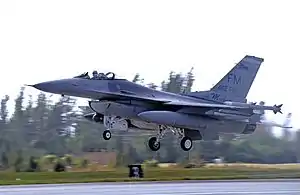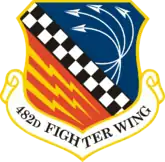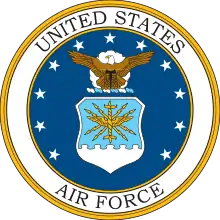482nd Fighter Wing
The 482nd Fighter Wing is an Air Reserve Component of the United States Air Force. It is assigned to the Tenth Air Force, Air Force Reserve Command, stationed at Homestead Air Reserve Base, Florida. If mobilized, the Wing is gained by the Air Combat Command.
| 482nd Fighter Wing | |
|---|---|
 F-16C Fighting Falcon of the 482nd Fighter Wing[note 1] | |
| Active | 1952; 1952–1957; 1981–present |
| Country | |
| Branch | |
| Type | Wing |
| Role | Fighter |
| Size | 1,600 personnel |
| Part of | |
| Garrison/HQ | Homestead Air Reserve Base, Florida |
| Decorations | Air Force Outstanding Unit Award |
| Insignia | |
| 482nd Fighter52 Wing emblem (approved 1989)[1] |  |
| Tail code | FM |
| Aircraft flown | |
| Fighter | F-16C Fighting Falcon |
The wing maintains and operates Homestead Air Reserve Base, located near the southern end of the Florida peninsula, about 25 miles south of Miami. It is a combat unit which provides General Dynamics F-16 Fighting Falcon fighter aircraft, along with mission ready pilots and support personnel, for short-notice worldwide deployment. The wing has approximately 1,600 members, including more than 1,200 reservists, of which 260 are full-time reservists, in addition to 325 full-time civilians.[2]
In addition to its flying mission, the 482d also provides the United States Department of Defense with an air base, with ready access to a strategic staging location on the rim of the Caribbean Basin. Contingency and training operations for both the United States Northern Command and United States Southern Command can be mounted from Homestead.
Units
All the wing's units are stationed at Homestead ARB, except for the 414th Fighter Group and its subordinate units.
- 414th Fighter Group (Seymour Johnson Air Force Base, North Carolina)
- 307th Fighter Squadron (F-15E Strike Eagle)
- 414th Maintenance Squadron
- 482nd Operations Group (F-16 Fighting Falcon)
- 93rd Fighter Squadron
- 482nd Operations Support Squadron
- 482nd Mission Support Group
- 482nd Civil Engineering Squadron
- 482nd Communications Squadron
- 482nd Contracting Squadron
- 482nd Logistics Readiness Squadron
- 482nd Mission Support Squadron
- 482nd Security Forces Squadron
- 482nd Services Squadron
- 482nd Maintenance Group
- 482nd Aircraft Maintenance Squadron
- 482nd Maintenance Operations Squadron
- 482nd Maintenance Squadron
- 482nd Medical Squadron
History
- For related history and lineage, see 482nd Operations Group
Troop carrier operations
All reserve combat organizations had been mobilized for the Korean War,[3] and it was not until the summer of 1952 that reserve units again began receiving aircraft.[4] The wing was first activated as the 482d Troop Carrier Wing in the reserve with Curtiss C-46 Commandos in June 1952 at Miami International Airport, Florida. The wing replaced the 906th Reserve Training Wing, which had been activated following the mobilization of the 435th Troop Carrier Wing for the Korean War, as reserve flying operations resumed under the supervision of the 2585th Air Force Reserve Training Center. In December, the 435th was released from active duty and assumed the mission, personnel and equipment of the 482d, which was inactivated.[5][note 2]
Fighter operations in the 1950s
In the early 1950s, the Air Force determined that all reserve units be designed to augment the regular forces in the event of a national emergency. Six reserve pilot training wings had no mobilization mission. On 18 May 1955, they were discontinued and replaced by three troop carrier wings and two fighter-bomber wings.[6] In this reorganization, the 94th Tactical Reconnaissance Wing at Dobbins Air Force Base, Georgia moved on paper to Scott Air Force Base to replace the 8711th Pilot Training Wing.[7][8] The 482d, now designated the 482d Fighter-Bomber Wing took over the 94th's personnel and equipment at Dobbins as one of the new reserve fighter units.[9]
The wing began training for the fighter mission, initially using Lockheed F-80 Shooting Star fighters, plus North American T-28 Trojan and Lockheed T-33 T-Bird trainers that it inherited from the 94th Wing.[7] Later that year, it began to equip with the Republic F-84 Thunderjet.[9] Despite its fighter bomber designation, the wing was gained by Air Defense Command (ADC) upon mobilization. ADC required the wing's squadrons to be designed to augment active duty squadrons capable of performing air defense missions for an indefinite period after mobilization independently of their parent wing.[10]
In 1957, the wing began to replace its Thunderjets with North American F-86 Sabres. However, The Joint Chiefs of Staff were pressuring the Air Force to provide more wartime airlift. At the same time, about 150 Fairchild C-119 Flying Boxcars became available from the active force. Consequently, in November 1956 the Air Force directed Continental Air Command to convert three reserve fighter bomber wings to troop carrier units in 1957.[11] Sabre training ended, and instead C-119s arrived in October 1957. In November the wing was inactivated and its troop carrier assets were transferred to the 445th Troop Carrier Wing.[1][12]
Fighter operations resume
The wing was reactivated in Florida and replaced the 915th Tactical Fighter Group in April 1981. The new base was Homestead Air Force Base, located near the southern end of the Florida peninsula, about 25 miles south of Miami. The wing controlled two McDonnell F-4 Phantom II-equipped tactical fighter groups at Bergstrom Air Force Base, Texas (1981–1982) and Wright-Patterson Air Force Base, Ohio (1982–1994). Following massive damage caused to Homestead Air Force Base by Hurricane Andrew in August 1992, the wing's flying operations were conducted from Wright-Patterson from September to December 1992 and from MacDill Air Force Base, Florida, from February 1993 until March 1994.[1]
The 482d became host wing at the now renamed Homestead Air Reserve Base on 1 April 1994 and provided weapons training support for Air Force units beginning in October 1994. From 1997, the 482d periodically deployed personnel and aircraft to Turkey to help enforce Operation Northern Watch, the no-fly zone over Northern Iraq.[1]
Lineage
- Established as 482nd Troop Carrier Wing, Medium on 26 May 1952
- Activated in the reserve on 14 June 1952
- Inactivated on 1 December 1952
- Redesignated 482nd Fighter-Bomber Wing on 12 April 1955
- Activated in the reserve on 18 May 1955
- Inactivated on 16 November 1957
- Redesignated 482nd Tactical Fighter Wing on 25 February 1981
- Activated in the reserve on 1 April 1981
- Redesignated 482nd Fighter Wing on 1 February 1992[1]
Assignments
- Fourteenth Air Force, 14 June – 1 December 1952
- Fourteenth Air Force, 18 May 1955 – 16 November 1957
- Tenth Air Force, 1 April 1981 – present[1]
Components
Groups
- 414th Fighter Group: 15 July 2010 – 1 October 2012[13]
- 482d Troop Carrier Group (later 482d Fighter-Bomber Group, 482d Operations Group): 14 June – 1 December 1952; 18 May 1955 – 16 November 1957; 1 August 1992 – present[1]
- 906th Tactical Fighter Group: 1 July 1982 – 30 September 1994[1]
- Wright-Patterson Air Force Base, Ohio
- 924th Tactical Fighter Group: 1 July 1981 – 1 October 1982[1]
- Bergstrom Air Force Base, Texas
- 482nd Maintenance Group
- 482nd Mission Support Group
Squadrons
- 93rd Fighter Squadron: 1 April 1981 – 1 August 1992[1]
- 482nd Medical Squadron
Stations
- Miami International Airport, Florida, 14 June – 1 December 1952
- Dobbins Air Force Base, Georgia, 18 May 1955 – November 1957
- Homestead Air Force Base (later Homestead Air Reserve Base), Florida, 1 April 1981 – present[1]
Aircraft
- Curtiss C-46 Commando, 1952
- Lockheed F-80 Shooting Star, 1955
- Republic F-84 Thunderjet, 1955–1957
- North American T-28 Trojan 1955–1957
- Lockheed T-33 T-Bird, 1955–1957
- North American F-86 Sabre, 1957
- Fairchild C-119 Flying Boxcar, 1957
- McDonnell F-4 Phantom II, 1981–1989
- General Dynamics F-16 Fighting Falcon, 1989–present[1]
See also
References
Notes
- Explanatory notes
- Aircraft is General Dynamics F-16C Block 30H Fighting Falcon serial 87–290.
- Although it had been mobilized in 1951, the 435th Wing remained in Miami as a training organization for C-46 crews deploying to the Far East. Ravenstein, p. 231. When it was released from active duty on 1 December 1952, its resources were taken over by the newly-activated 456th Troop Carrier Wing, while it took over those of the 482d. Ravenstein, pp. 231, 251, 268.
- Citations
- Endicott, Judy G. (28 December 2007). "Factsheet 482 Fighter Wing (AFRC)". Air Force Historical Research Agency. Archived from the original on 27 September 2015. Retrieved 25 July 2016.
- "Homestead Air Reserve Base Units: 482nd Fighter Wing". 482d Fighter Wing Public Affairs. October 2013. Archived from the original on 6 October 2014. Retrieved 28 July 2016.
- Cantwell, p. 87
- Cantwell, p. 139
- Ravenstein, pp. 230–231, 267–268
- Cantwell, p. 146
- Robertson, Patsy (9 August 2010). "Factsheet 94 Airlift Wing (AFRC)". Air Force Historical Research Agency. Archived from the original on 18 August 2016. Retrieved 7 July 2016.
- Mueller, p. 518
- Ravenstein, pp. 267–268
- Cantwell, p. 148
- Cantwell, p. 168
- Ravenstein, pp. 241–242
- Robertson, Patsy (9 May 2013). "Factsheet 414 Fighter Group (AFRC)". Air Force Historical Research Agency. Archived from the original on 18 August 2016. Retrieved 14 September 2013.
Bibliography
![]() This article incorporates public domain material from the Air Force Historical Research Agency website http://www.afhra.af.mil/.
This article incorporates public domain material from the Air Force Historical Research Agency website http://www.afhra.af.mil/.
- Cantwell, Gerald T. (1997). Citizen Airmen: a History of the Air Force Reserve, 1946–1994. Washington, D.C.: Air Force History and Museums Program. ISBN 0-16049-269-6. Retrieved 1 October 2014.
- Mueller, Robert (1989). Air Force Bases, Vol. I, Active Air Force Bases Within the United States of America on 17 September 1982 (PDF). Washington, DC: Office of Air Force History. ISBN 0-912799-53-6.
- Ravenstein, Charles A. (1984). Air Force Combat Wings, Lineage & Honors Histories 1947–1977. Washington, DC: Office of Air Force History. ISBN 0-912799-12-9.
External links
- "Homestead Air Reserve Base Home Page". 482d Fighter Wing Public Affairs. Retrieved 28 July 2016.

